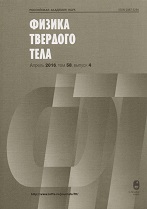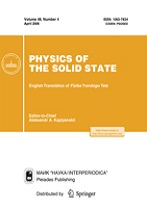|
This article is cited in 15 scientific papers (total in 15 papers)
Semiconductors
Studying evolution of the ensemble of micropores in a SiC/Si structure during its growth by the method of atom substitution
A. V. Redkovab, A. S. Grashchenkoab, S. A. Kukushkinabc, A. V. Osipovab, K. P. Kotlyarde, A. I. Lihachevde, A. V. Nashchekinde, I. P. Soshnikovde
a Institute of Problems of Mechanical Engineering, Russian Academy of Sciences, St. Petersburg
b St. Petersburg National Research University of Information Technologies, Mechanics and Optics
c Peter the Great St. Petersburg Polytechnic University
d Federal State Budgetary Institution of Higher Education and Science Saint Petersburg National Research Academic University of the Russian Academy of Sciences, St. Petersburg
e Ioffe Institute, St. Petersburg
Abstract:
The time evolution of the ensemble of micropores formed in the near-surface region of silicon during the growth of thin films of silicon carbide is studied by the method of atom substitution. SiC/Si samples are studied by scanning electron microscopy, ellipsometry, and confocal Raman microscopy. The formation of the porous layer involves several characteristic stages: the emergence of single pores, their growth with the formation of dendrite-like structures, and subsequent coalescence into a continuous layer. It is shown that the thickness of the porous layer at the initial stages of the growth is proportional to the cubic root of time. The possible mechanisms of pore formation are discussed and a theoretical model is proposed to describe the dependence of the average thickness of the porous layer on time. The model is in a good qualitative agreement with the experimental results.
Received: 22.10.2018
Citation:
A. V. Redkov, A. S. Grashchenko, S. A. Kukushkin, A. V. Osipov, K. P. Kotlyar, A. I. Lihachev, A. V. Nashchekin, I. P. Soshnikov, “Studying evolution of the ensemble of micropores in a SiC/Si structure during its growth by the method of atom substitution”, Fizika Tverdogo Tela, 61:3 (2019), 433–440; Phys. Solid State, 61:3 (2019), 299–306
Linking options:
https://www.mathnet.ru/eng/ftt8877 https://www.mathnet.ru/eng/ftt/v61/i3/p433
|


| Statistics & downloads: |
| Abstract page: | 52 | | Full-text PDF : | 16 |
|



 Contact us:
Contact us: Terms of Use
Terms of Use
 Registration to the website
Registration to the website Logotypes
Logotypes